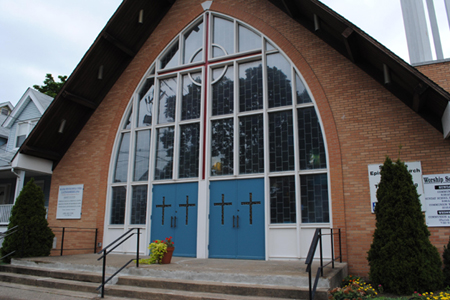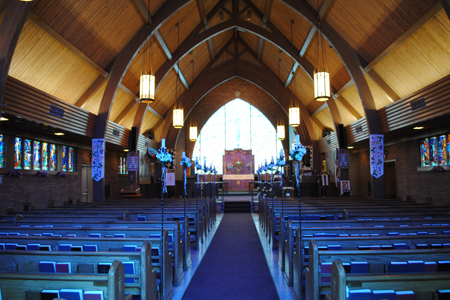| |
 |
 |
 |
| Comment on this report, or find other reports. |
 |
| Our Mystery Worshippers are volunteers who warm church pews for us around the world. If you'd like to become a Mystery Worshipper, start here. |
 |
| Find out how to reproduce this report in your church magazine or website. |
|
|
| 2106: St Peter's,
Clifton, New Jersey, USA (in association with Oasis and Positive
Connection) |
 |
 |
 |
Mystery
Worshipper: Brother Juniper.
The church:
St
Peter's, Clifton, New Jersey, USA (in association with Oasis
and Positive
Connection).
Denomination:
The
Episcopal Church, Diocese
of Newark.
The building:
This is one of several plain vanilla, contemporary church buildings
in the area – which leads me to wonder if someone paid an architect
once and used the plans for every church built between 1960
and 1990. Structured of beige brick, and built in a rather triangular
shape, St Peter's is saved from plainness by stained glass depicting
religious figures and a nicely decorated chancel and altar.
For tonight's service, there was a section set aside at the
chancel steps where participants could light a small candle
from the paschal candle and place it in a box nearby, in memory
of those who have died from AIDS.
The church:
St Peter's has taken many initiatives for the poor and alienated,
clearly in a very concrete fashion. In this computer era, it
might be accurate to use the term "hands-on ministry"
– there are very practical offerings to assist those in
need of food and basic necessities, and varied organizations
for addicts and others in crisis. Though not a large church,
St Peter's takes such welcoming (and welcomed, as response has
shown) initiatives as posting greetings for Muslim holidays.
The neighborhood:
Clifton is a large industrial city that maintains a vague air
of being suburban with its landscaping and zoning regulations.
St Peter's is in an older section of Clifton, originally settled
in the Dutch colonial era and still containing a substantial
population of Dutch Reformed, whose families are pre-historic
(history having naturally begun in 1776). The strictness of
the Dutch Reformed, whose own church is nearby, is quite a contrast
to St Peter's.
The cast:
This special service was a combined effort of the church and
several organizations, including Positive Connection, a support
group for persons with AIDS or who are HIV positive; and Oasis,
a diocesan program for gay/lesbian/bisexual/transgender concerns.
The Revd Peter DeFranco, rector, presided. The guest speaker
was Gary Paul Wright, founder of African
American Office of Gay Concerns. Churchwarden Michael Petti
led the remembrance of the dead.
The date & time:
December 1, 2010 (World AIDS Day), 7.30pm.
What was the name of the service?
World AIDS Day Service of Remembrance and Healing.
How full was the building?
About 30 people were in attendance – perhaps a third of the
church's capacity.
Did anyone welcome you personally?
I was greeted and provided with a service leaflet and a card
on which I could write the names of friends and relatives who
had died of AIDS; these cards would be read aloud later.
Was your pew comfortable?
Yes – quite standard.
How would you describe the pre-service
atmosphere?
I arrived only a few minutes before the service began. The pianist
(Ernie Pianezza) was playing a prelude. Most people were already
seated. Save for some nods and smiles at acquaintances, it was
quiet.
What were the exact opening words of the
service?
"Good evening." This by the rector, who then introduced himself
and the guest participants and mentioned the organizations taking
part in the effort. The actual service began with: "We gather
in the name of the Blessed Trinity, one God, now and forever.
Come, Spirit, come, and show us faith sure enough to move mountains."
What books did the congregation use during the
service?
There was a printed leaflet containing all prayers and hymns.
What musical instruments were played?
Piano.
Did anything distract
you?
Between the AIDS memorial quilt and banners in the chancel (not
that I did not appreciate the significance), there were a few
too many images up front for me to process (at least at the
same time as I'm sadly recalling those whom I've known who have
died of AIDS). I also was distracted at my prayer because, though
I loved the petitions and readings, the sort of folksy hymns
are of a genre I dislike immensely.

Was the worship stiff-upper-lip,
happy clappy, or what?
The service was quiet and simple, but very moving. We prayed
a litany, for example, responding with "I will not forget you,
says our God," with the leader adding petitions for everyone
affected by HIV – examples being clinic workers, widows
with children, wives who contracted HIV from a husband's infidelity.
Prayers emphasized that we, as Church, are the body of Christ
– and are all affected by HIV and the sufferings of the
Church's members.
Exactly how long was the sermon?
10 minutes.
On a scale of 1-10, how
good was the preacher?
I cannot really assess this. Gary Paul Wright seemed an engaging
speaker with an outgoing manner. A part of me sensed that his
was a dynamic personality, and his experience made me imagine
one who is quite a powerful and persuasive speaker. But I also
sensed that he was acting with some caution, not knowing the
congregation, by being very brief and only occasionally adding
a note of wit.
In a nutshell, what was
the sermon about?
It was not a sermon per se. The guest speaker largely gave a
capsule history of HIV awareness, initiatives, and progress,
including political positions during various presidential administrations.
Which part of the service
was like being in heaven?
The obvious caring of all who were present, and the prayers
and petitions, which expressed an exceptional awareness of the
practical sides of suffering. They did this in all dimensions
related to AIDS, not only the physical pain. The prayers were
reminders that God remains active in creation and offers us
a part in his love. "May we, like you (God), write the names
of the world's forgotten people on the palms of our hands" is
one example.
And which part was like being in... er... the other place?
Though the service itself was warm and peaceful, I naturally
felt pain in remembering the suffering I have seen in those
who have AIDS.
What happened when you hung around after the service looking lost?
I was acquainted with a few of those in attendance, so I was able to settle in at the after-service coffee hour easily enough.
How would you describe the after-service
coffee?
Coffee, tea, cakes, and (to my delight) fresh melon and berries
were all on offer.
How would you feel about
making this church your regular (where 10 = ecstatic, 0 = terminal)?
I'd rather not give a rating at all. It is unfair for me to
judge the church's appeal overall based on a single service,
uncharacteristic and for a singular occasion.
Did the service make you
feel glad to be a Christian?
It did indeed. The prayers and petitions, not only by recognizing
how the Church is body of Christ, but also by specific mention
of everyone – from grandmothers taking on broods when AIDS
patients die, to clinic workers, children losing parents, and
so forth – seemed truly to be liturgy (in the sense of work
of the people), even if my own liturgical tastes are more highbrow
and formal.
What one thing will you remember about all this in seven days' time?
An excerpt from one of the prayers summarizes the overall sense
of the service: "We thank you, Father, that you are always compassionate.
We thank you that you do not forget those whom the world so
quickly forgets. May we be among those who refuse to forget." |
|
|
 |
 |
 |
| We rely on voluntary donations to stay online. If you're a regular visitor to Ship of Fools, please consider supporting us. |
 |
 |
 |
| The Mystery Pilgrim |
 |
| One of our most seasoned reporters makes the Camino pilgrimage to Santiago de Compostela in Spain. Read here. |
 |
 |
 |
| London churches |
 |
| Read reports from 70 London churches, visited by a small army of Mystery Worshippers on one single Sunday. Read here. |
| |
|
|
|
|


